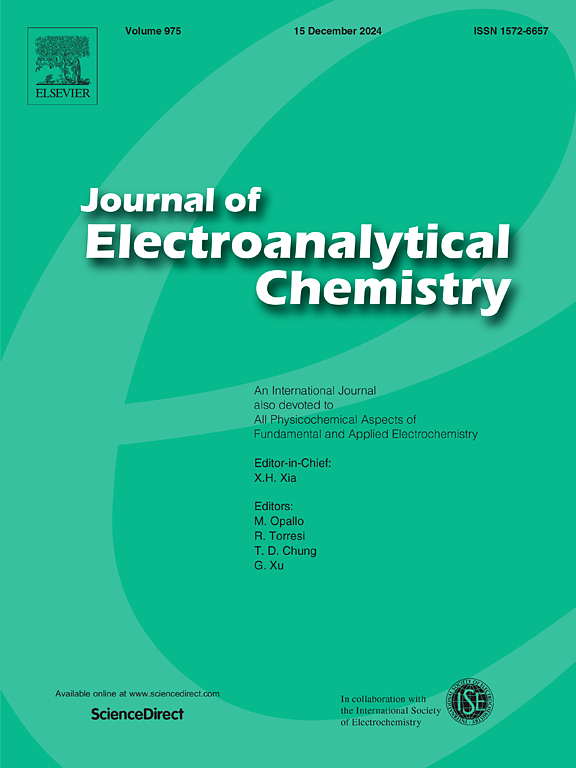SOC estimation of lithium-ion batteries using equivalent circuit model and Nyquist plots from EIS data: A machine learning approach
IF 4.1
3区 化学
Q1 CHEMISTRY, ANALYTICAL
引用次数: 0
Abstract
Lithium-ion batteries (LIBs) are currently the most widely used new energy storage devices, whose state of charge (SOC) estimation is critical for their safe operation. Electrochemical impedance spectroscopy (EIS) reveals detailed characteristics of the LIB's electrochemical state, making it useful for SOC estimation. This paper proposes a SOC estimation method based on random forest (RF) combined with a convolutional neural network (CNN) (RF-CNN algorithm) using an equivalent circuit model (ECM) and Nyquist plots from EIS data. Firstly, the ECM parameters are fitted from the 1D EIS data. Then, CNNs are employed to extract the image features (shapes and edges) from the 2D Nyquist plot of EIS data. Finally, the fitted ECM parameters, along with the extracted image features, serve as inputs for the RF algorithm, in which Optuna is utilized for hyperparameter tuning to refine SOC estimation. Experiments on open-access EIS datasets of LIBs demonstrate that the proposed SOC estimation method achieves the best performance in terms of accuracy and speed with a determination coefficient of 0.9926 in 5-fold cross-validation. By integrating 1D ECM parameters with 2D Nyquist plot features, this paper establishes an effective SOC estimation method for LIBs based on the RF-CNN machine learning approach and has important reference values for battery SOC estimation based on small-sample EIS datasets.
利用等效电路模型和来自EIS数据的Nyquist图估算锂离子电池的SOC:一种机器学习方法
锂离子电池是目前应用最广泛的新型储能设备,其荷电状态(SOC)的估算对其安全运行至关重要。电化学阻抗谱(EIS)揭示了锂离子电池电化学状态的详细特征,使其能够用于电池荷电状态的估计。本文利用等效电路模型(ECM)和来自EIS数据的Nyquist图,提出了一种基于随机森林(RF)和卷积神经网络(CNN)的SOC估计方法(RF-CNN算法)。首先,利用一维EIS数据拟合ECM参数;然后,利用cnn从EIS数据的二维Nyquist图中提取图像特征(形状和边缘)。最后,拟合的ECM参数以及提取的图像特征作为RF算法的输入,其中使用Optuna进行超参数调优以改进SOC估计。在开放获取的LIBs EIS数据集上进行的实验表明,所提出的SOC估计方法在准确率和速度方面都达到了最佳效果,5倍交叉验证的决定系数为0.9926。通过将一维ECM参数与二维Nyquist图特征相结合,建立了一种有效的基于RF-CNN机器学习方法的电池荷电状态估计方法,对基于小样本EIS数据集的电池荷电状态估计具有重要的参考价值。
本文章由计算机程序翻译,如有差异,请以英文原文为准。
求助全文
约1分钟内获得全文
求助全文
来源期刊
CiteScore
7.80
自引率
6.70%
发文量
912
审稿时长
2.4 months
期刊介绍:
The Journal of Electroanalytical Chemistry is the foremost international journal devoted to the interdisciplinary subject of electrochemistry in all its aspects, theoretical as well as applied.
Electrochemistry is a wide ranging area that is in a state of continuous evolution. Rather than compiling a long list of topics covered by the Journal, the editors would like to draw particular attention to the key issues of novelty, topicality and quality. Papers should present new and interesting electrochemical science in a way that is accessible to the reader. The presentation and discussion should be at a level that is consistent with the international status of the Journal. Reports describing the application of well-established techniques to problems that are essentially technical will not be accepted. Similarly, papers that report observations but fail to provide adequate interpretation will be rejected by the Editors. Papers dealing with technical electrochemistry should be submitted to other specialist journals unless the authors can show that their work provides substantially new insights into electrochemical processes.

 求助内容:
求助内容: 应助结果提醒方式:
应助结果提醒方式:


